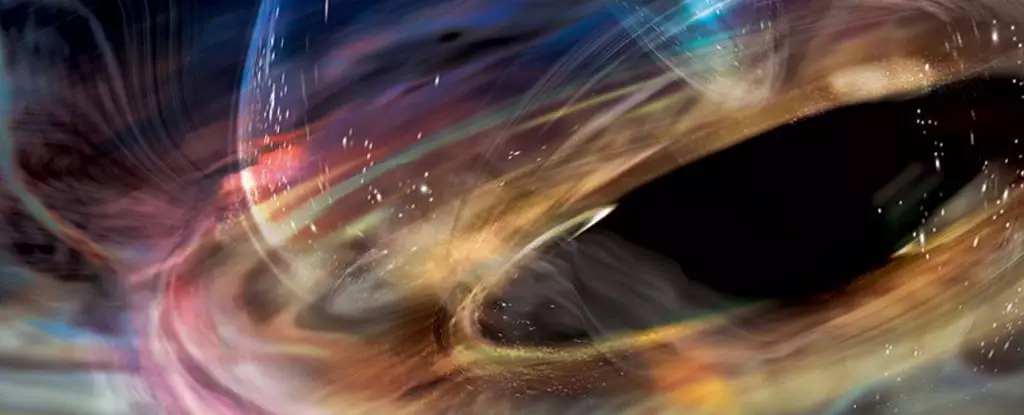The universe is vast and full of mysteries, some of which reside in the depths of distant galaxies. Approximately 275 million light-years away from our Milky Way, the galaxy known as 1ES 1927+654 contains a supermassive black hole that has unfurled a series of peculiar behaviors, leaving astronomers puzzled and intrigued. Recent observations have suggested a potential explanation involving an unlikely companion: a white dwarf star that appears to be orbiting perilously close to the black hole’s event horizon. This article delves into the significance of this discovery and its implications for understanding black holes and stellar formation.
Unpacking the Mystery: The Behavior of 1ES 1927+654
The black hole at the center of 1ES 1927+654 is estimated to have a mass roughly 1 million times that of the Sun, placing it in the category of supermassive black holes found at the cores of most galaxies. Before 2018, this black hole exhibited behavior commonly associated with objects of its kind, but an unexpected change was observed when its surrounding corona of material dimmed and then intensified in brightness—an increase of nearly 20 times its previous luminosity. This sudden fluctuation caught the attention of scientists, who speculated about the potential mechanisms behind such behavior.
Astrophysicists speculated several theories, including the possibility of a polar reversal, an event that had never been documented previously. However, more intriguing phenomena were yet to come. By June 2022, X-ray observations using the European Space Agency’s XMM-Newton telescope revealed erratic fluctuations in brightness from the black hole’s core. The black hole was producing X-rays that varied in intensity by 10 percent over intervals of approximately 18 minutes—a finding that was both fascinating and bizarre.
The Role of X-Ray Observations in Black Hole Studies
The fluctuations observed in X-rays are not entirely foreign in black hole studies; they are known as quasi-periodic oscillations (QPOs). Though their exact origins remain unknown, QPOs typically suggest an object moving closely around a black hole, providing valuable insights into the black hole’s environment and the nature of spacetime under extreme gravitational influence.
As researchers reviewed the evidence, there was a noticeable shift in the frequency of these fluctuations. Over two years, the time intervals between oscillations diminished from 18 minutes to less than seven. Such rapid change in oscillative behavior was unprecedented and diverged from typical manifestations seen in known black holes. This necessitated a closer look at the conditions surrounding 1ES 1927+654.
To understand what might be happening in this extreme gravitational scenario, researchers focused on the unusual light patterns and their frequency. Erin Kara, a physicist at the Massachusetts Institute of Technology, noted that these characteristics suggest a dense object likely in close orbit around the black hole. Through calculations, the team determined that the most probable candidate for this companion was a white dwarf star—a remnant formed from the core of a low-mass star that has shed its outer layers.
The proximity of this white dwarf to the black hole is astonishing. It orbits closer than many objects previously recorded, with a radius only 4.2 times that of our Sun. As it whirls around the black hole, the gravitational forces are so intense that they begin to strip away the white dwarf’s outer layers, creating an intricate cosmic dance sculpted by force and momentum.
Interestingly, the extraordinary density of a white dwarf may protect it from being consumed entirely by the black hole. As the black hole pulls at its outer material, the white dwarf experiences enough “kickback” momentum to potentially evade the point of no return. The possibility exists that, over time, it may withdraw to a safer orbit, allowing scientists to observe how the X-ray oscillations evolve in response—an event that would provide further insights into the dynamics of such extreme cosmic environments.
The implications of these findings demand continued observation of 1ES 1927+654. As physicist Megan Masterson emphasized, the data collected so far has opened a window into phenomena seldom observed before and highlights how little we truly understand about the complex interactions between black holes and neighboring celestial bodies.
The 1ES 1927+654 black hole and its white dwarf companion highlight the wonders of cosmic exploration, presenting new opportunities for research and prompting a re-evaluation of the properties and behaviors surrounding black holes in general. As researchers continue to monitor this galactic locus, it becomes increasingly clear that each observation is a step toward unraveling the universe’s enigmatic tapestry. The journey into the depths of space remains an exhilarating testament to human curiosity and scientific endeavor.

